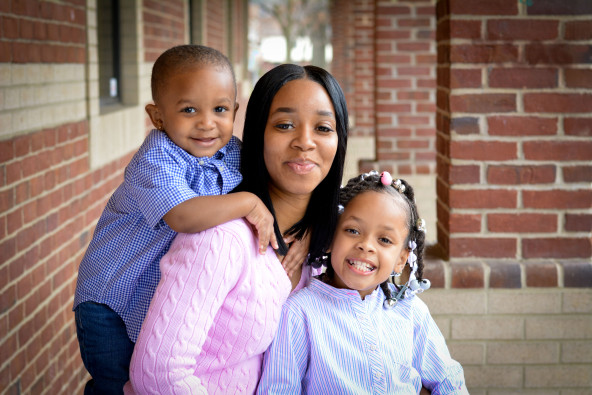I vividly remember the fall of 2016. Some of us from the Brighton Center, which provides workforce training, education, housing, and other support services to low-income communities in Northern Kentucky, were at a convening of grantees funded by the W. K. Kellogg Foundation. We came together to discuss Supporting Transitions to Employment for Parents (STEPS), a program that aims to ensure that more low-income parents have the skills and opportunities to move onto and up the ladder of economic success. The conversation turned to racial equity. A presenter from the foundation said that if an organization’s approach to addressing equity in a community is to form a committee or to conflate equity with equality, diversity, and inclusion, then it is going to have difficulty making progress.
As I listened, I had one of those, “Wait … what?” moments. I pulled out the work plan that Brighton Center had so thoughtfully crafted to guide our STEPS project, flipped to the racial equity section—a portion of the plan the foundation asked us to complete as part of our grant planning—and began skimming the words. The plan I had previously considered strong suddenly seemed inadequate. I realized I been confusing the concepts of equity, and equality, diversity, and inclusion. And I did not make the connection that racial, ethnic, and gender disparities in Brighton Center’s community were in fact an “equity” issue. Questions came to mind: Had we really addressed disparity? Were we blending our definitions of equality, diversity, inclusion, and equity, and therefore “watering down” each concept?
 A mother and her children, who are participants in Brighton Center programs.
A mother and her children, who are participants in Brighton Center programs.

Following this experience, I felt empowered to dig deeper into the underlying causes of disparities the people we aim to help have experienced. Through data we collect about our programs, I wanted to learn more about racial, ethnic, and gender disparities in employment, in housing access, and in the number of people who access our services. Through analyzing these data, our understanding of disparities, and how to identify them, has become much sharper. I was truly looking at our work plan through a new lens, and I was energized!
When our executive vice president attended Race Forward’s national Facing Race conference, she returned equally energized. We were ready to set a racial equity strategy in motion.
Brighton Center was founded in response to the needs of a large Appalachian population that migrated north, settling in Newport, Kentucky in search of work and a better life in the riverfront economy. In the spring of 1994, Brighton Center's programs were reconfigured to reflect a family resource center model of service delivery. The model encouraged individuals to assume maximum responsibility for their own lives, but was rooted in the idea that people are a resource to be cultivated—not a problem to be “fixed.” Families connect with our staff as partners, and set their own goals for self-sufficiency (such as employment, housing, parenting, or financial goals). Families “drive the bus” while our staff coach them through the process.
Given our mission to create opportunities for individuals and families to reach self-sufficiency through family support services, education, employment, and leadership, we realized that we must use a racial equity lens that identifies and calls out disparities, and addresses them both within our organization and among the multiple systems our families interact with daily. We realized that really eliminating disparities requires that we constantly reflect on what we do and how we do it. We knew these would be tough, uncomfortable conversations about topics such as race and privilege, and how our organization should define equity. It became apparent that the more we learned, the more we needed to learn.
We began by asking several questions:
- Are our core values aligned with our racial equity commitment?
- Is our commitment formalized into our strategic plan?
- Do we have an infrastructure that will sustain our commitment to racial equity?
- What training should we provide our staff to prepare them for equity work?
- Are we equipped to collect and report data that identifies where disparities exists?
- Do we have the tools to walk through resistance to our commitment?
Our first responses were foundational. We added a core value to our other nine organizational values, which are part of our strategic plan and frame all of our programs, that specifically addresses racial equity. It reads, “Commitment to diversity, inclusion, and racial equity are imperative to the strength of our organization and community.” In addition, we defined equity as the “systematic fair treatment of all people of all races that results in equitable opportunities and outcomes for everyone.” We established that definition as a central component of Brighton Center’s strategic plan, and developed a goal to “internally create, and externally participate in, the dialog and actions to advance racial equity.”
This commitment to equity bridges our internal work to our broader community work. Our customers often face inequities in child care, housing, and education. It is our responsibility as a social service organization to apply an equity lens, and understand how we can try to change systems that perpetuate disparities. As one action step, we are developing a database that will enable us to view outcomes of our services by race, ethnicity, and gender. Based on what we learn, we can then determine the most appropriate programs and interventions to remedy any disparities.
As we continue to share experiences on this journey, we recommend that organizations adopting an equity lens consider the following:
- Understand how your organizational culture may further or impede your efforts.
- Realize that the important and worthwhile work of inclusion, diversity, and equality are different and unique from equity. We believe that equity–and viewing our work through an equity lens–must also be addressed in an actionable manner, because it brings us closest to eradicating disparities.
- You cannot improve racial equity without first identifying and addressing disparity.
- Be prepared to talk explicitly about race and implicit bias.
- Understand your community and be willing to challenge systems.
We have begun work that we know has no end. This endeavor will require continued growth, discovery, and at times discomfort as we challenge our policies, procedures, and practices. Ultimately, we aspire to be a part of a regional change. We are resolved to challenging beliefs and modeling the way.
Support SSIR’s coverage of cross-sector solutions to global challenges.
Help us further the reach of innovative ideas. Donate today.
Read more stories by Melissa Hall Sommer.

